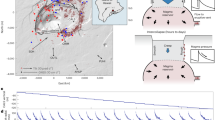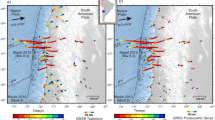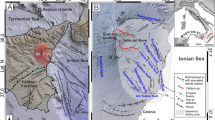Abstract
Large earthquakes can generate small changes in static stress: increases that trigger aftershock swarms, or reductions that create a region of reduced seismicity—a stress shadow1,2. However, seismic waves from large earthquakes also cause transient dynamic stresses that may trigger seismicity3,4. This makes it difficult to separate the relative influence of static and dynamic stress changes on aftershocks. Dyke intrusions do not generate dynamic stresses, so provide an unambiguous test of the stress shadow hypothesis. Here we use GPS and seismic data to reconstruct the intrusion of an igneous dyke that is 46 km long and 5 m wide beneath Bárðarbunga Volcano, central Iceland, in August 2014. We find that during dyke emplacement, bursts of seismicity at a distance of 5 to 15 km were first triggered and then abruptly switched off as the dyke tip propagated away from the volcano. We calculate the evolving static stress changes during dyke propagation and show that the stressing rate controls both the triggering and then suppression of earthquake rates in three separate areas adjacent to the dyke. Our results imply that static stress changes help control earthquake clustering. Similar small static stress changes may be important for triggering seismicity near geothermal areas, regions being hydrofractured and deflating oil and gas fields.
This is a preview of subscription content, access via your institution
Access options
Subscribe to this journal
Receive 12 print issues and online access
$259.00 per year
only $21.58 per issue
Buy this article
- Purchase on Springer Link
- Instant access to full article PDF
Prices may be subject to local taxes which are calculated during checkout



Similar content being viewed by others
References
Stein, R. S. The role of stress transfer in earthquake occurrence. Nature 402, 605–609 (1999).
Steacy, S., Gomberg, J. & Cocco, M. Introduction to special section: Stress transfer, earthquake triggering, and time-dependent seismic hazard. J. Geophys. Res. 110, B05S01 (2005).
Kilb, D., Gomberg, J. & Bodin, P. Triggering of earthquake aftershocks by dynamic stresses. Nature 408, 570–574 (2000).
Harris, R. A. Introduction to special section: Stress triggers, stress shadows, and implications for seismic hazard. J. Geophys. Res. 103, 347–358 (1998).
Doser, D. I. & Robinson, R. Modelling stress changes induced by earthquakes in the southern Marlborough region, South Island, New Zealand. Bull. Seismol. Soc. Am. 92, 3229–3238 (2002).
Toda, S. & Stein, R. S. Toggling of seismicity by the 1997 Kagoshima earthquake couplet: A demonstration of time-dependent stress transfer. J. Geophys. Res. 108, B122527 (2003).
Reasenberg, P. A. & Simpson, R. W. Response of regional seismicity to the static stress change produced by the Loma Prieta Earthquake. Science 255, 1687–1690 (1992).
Parsons, T., Stein, R. S., Simpson, R. W. & Reasenberg, P. A. Stress sensitivity of fault seismicity: A comparison between limited-offset oblique and major strike-slip faults. J. Geophys. Res. 104, 183–202 (1999).
Segall, P. E. K., Llenos, A. L., Yun, S.-H., Bradley, A. M. & Syracuse, E. M. Time-dependent dike propagation from joint inversion of seismicity and deformation data. J. Geophys. Res. 118, 5785–5804 (2013).
Felzer, K. R. & Brodsky, E. E. Testing the stress shadow hypothesis. J. Geophys. Res. 110, B05S09 (2005).
Mallman, E. P. & Zoback, M. D. Assessing elastic coulomb stress transfer models using seismicity rates in southern California and southwestern Japan. J. Geophys. Res. 112, B03304 (2007).
Sigmundsson, F. et al. Segmented lateral dyke growth in a rifting event at Bárðarbunga volcanic system, Iceland. Nature 517, 191–195 (2015).
Jakobsdóttir, S. S. Seismicity in Iceland: 1994–2007. Jökull 58, 75–100 (2008).
Dieterich, J. A constitutive law for rate of earthquake production and its application to earthquake clustering. J. Geophys. Res. 99, 2601–2618 (1994).
Ader, T. J., Lapusta, N., Avouac, J.-P. & Ampuero, J.-P. Response of rate-and-state seismogenic faults to harmonic shear-stress perturbations. Geophys. J. Int. 198, 385–413 (2014).
Toda, S., Stein, R. S., Beroza, G. C. & Marsan, D. Aftershocks halted by static stress shadows. Nature Geosci. 5, 410–413 (2012).
Stein, R. S., King, G. C. P. & Lin, J. Change in failure stress on the southern San Andreas Fault system caused by the 1992 Magnitude = 7.4 Landers Earthquake. Science 258, 1328–1332 (1992).
Dieterich, J. H., Cayol, V. & Okubo, P. The use of earthquake rate changes as a stress meter at Kilauea Volcano. Nature 408, 457–460 (2000).
Toda, S., Stein, R. S. & Sagiya, T. Evidence from the AD 2000 Izu islands earthquake swarm that stressing rate governs seismicity. Nature 419, 58–61 (2002).
Segall, P., Desmarais, E. K., Shelly, D., Miklius, A. & Cervelli, P. Earthquakes triggered by silent slip events on Kilauea volcano, Hawaii. Nature 442, 71–74 (2006).
Lohman, R. B. & McGuire, J. J. Earthquake swarms driven by aseismic creep in the Salton Trough, California. J. Geophys. Res. 112, B04405 (2007).
Drew, J., White, R. S., Tilman, F. & Tarasewicz, J. Coalescence microseismic mapping. Geophys. J. Int. 195, 1773–1785 (2013).
Lomax, A., Virieux, J., Volant, P. & Berge, C. Advances in Seismic Event Location (Kluwer, 2000).
Darbyshire, F. A., Bjarnason, I. T., White, R. S. & Flovenz, O. Crustal structure above the Iceland mantle plume imaged by the ICEMELT refraction profile. Geophys. J. Int. 135, 1131–1149 (1998).
Wadati, K. On the travel time of earthquake waves. Geophys. Mag. 7, 101–111 (1933).
Waldhauser, F. & Ellsworth, W. A double-difference earthquake location algorithm: Method and application to the northern Hayward fault, California. Bull. Seismol. Soc. Am. 90, 1353–1368 (2000).
Reasenberg, P. & Oppenheimer, D. H. FPFIT, FPPLOT, FPPAGE: Fortran Computer Programs for Calculating and Displaying Earthquake Fault-Plane Solutions Report No. 85–739 (USGS, 1985).
Okada, Y. Internal deformation due to shear and tensile faults in a half-space. Bull. Seismol. Soc. Am. 82, 1018–1040 (1992).
Toda, S., Stein, R. S., Richards-Dinger, K. & Bozkurt, S. Forecasting the evolution of seismicity in southern California: Animations built on earthquake stress transfer. J. Geophys. Res. 110, B05S16 (2005).
Lin, J. & Stein, R. S. Stress triggering in thrust and subduction earthquakes and stress interaction between the southern San Andreas and nearby thrust and strike-slip faults. J. Geophys. Res. 109, B02303 (2004).
Auriac, A. et al. InSAR observations and models of crustal deformation due to a glacial surge in Iceland. Geophys. J. Int. 198, 1329–1341 (2014).
Martens, H. R. & White, R. S. Triggering of microearthquakes in Iceland by volatiles released from a dyke intrusion. Geophys. J. Int. 194, 1738–1754 (2013).
Hainzl, S., Steacy, S. & Marsan, D. Seismicity models based on Coulomb stress calculations. Community Online Resour. Stat. Seismicity Anal. http://dx.doi.org/10.5078/corssa-32035809 (2010).
Acknowledgements
Seismometers were borrowed from the Natural Environment Research Council (NERC) SEIS-UK (loans 968 and 1022), and the work was financially supported by research grants from the NERC and FutureVolc, with graduate studentships from the NERC and Shell. We thank T. Ágústsdóttir, B. Brandsdóttir, H. Soosalu, S. Steinþórsson and all those who assisted with fieldwork in Iceland. We are very grateful to J.-P. Avouac for detailed discussions on earthquake stress triggering and stress shadows, and to P. Segall for constructive comments. C. Bean (University College Dublin), the British Geological Survey and Icelandic Meteorological Office (IMO) kindly provided additional data from their seismometers in northeast Iceland: data delivery from IMO seismic database 20141124/01. Department of Earth Sciences, Cambridge contribution number ESC3285.
Author information
Authors and Affiliations
Contributions
All authors participated in data collection from seismometers deployed in Iceland by the Cambridge group, in processing and analysing the seismic data and in interpretation of the results. Geodetic modelling was carried out by T.G. and R.G.G. analysed the seismicity and stressing rates. All authors contributed to preparation of the manuscript.
Corresponding author
Ethics declarations
Competing interests
The authors declare no competing financial interests.
Supplementary information
Supplementary Information
Supplementary Information (PDF 2855 kb)
Supplementary Movie
Supplementary Movie (MOV 8179 kb)
Supplementary Movie
Supplementary Movie (MOV 4307 kb)
Supplementary Information
autolocation_bardeqs.csv (CSV 6 kb)
Supplementary Information
autolocation_kisteqs.csv (CSV 14 kb)
Supplementary Information
autolocation_kverkeqs.csv (CSV 3 kb)
Supplementary Information
cambridge_velocity_model.csv (CSV 0 kb)
Supplementary Information
dyke_and_deflation_model.csv (CSV 9 kb)
Supplementary Information
manual_locations_Kistufell_fps.csv (CSV 2 kb)
Supplementary Information
manual_locations_Kverkfjoll_fps.csv (CSV 0 kb)
Supplementary Information
manual_locations_NEbard_fps.csv (CSV 1 kb)
Rights and permissions
About this article
Cite this article
Green, R., Greenfield, T. & White, R. Triggered earthquakes suppressed by an evolving stress shadow from a propagating dyke. Nature Geosci 8, 629–632 (2015). https://doi.org/10.1038/ngeo2491
Received:
Accepted:
Published:
Issue Date:
DOI: https://doi.org/10.1038/ngeo2491



